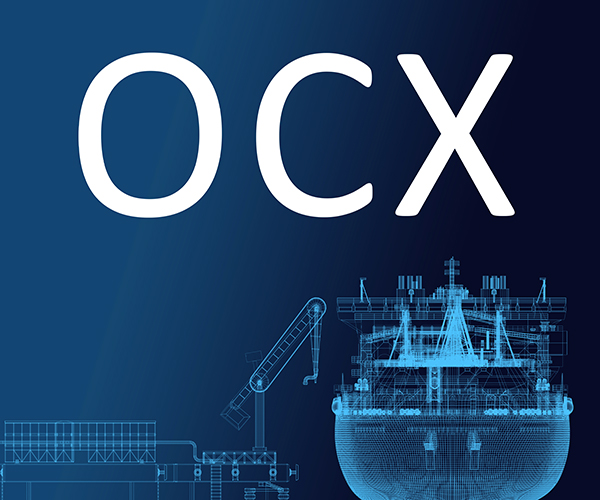
|
PROSTEP Fully Supports OCX-Based Data Exchange in the Shipbuilding IndustryBy Carsten Zerbst The OCX standard used to exchange ship moulded forms and structures is on its why to industrial practice. Developed in the APPROVE research project, it is now seen as a viable solution by both users from shipyards and classification societies as well as CAx solution providers. PROSTEP is a member of the OCX consortium and helps customers to apply OCX-based data exchange. 
The shipbuilding industry embraced 3D design decades ago, otherwise it would be nearly impossible to design these gigantic structures housing hundreds of km of piping and cable. But when it comes to the early design phase, shipyards, design companies, and classification societies still exchange drawings of the hull structure or redesign it in special calculation tool. Classification societies require this information to check the design concerning factors like strength or escape routes. The OCX standard is intended to support seamless data exchange and drastically reduce the time and effort needed to create drawings or redesign in special calculation tools. For years, data exchange was hampered by the fact that shipyards were reluctant to exchange detailed 3D models. They were afraid that valuable company know-how could fall into the hands of the competition. This was considered when defining the OCX standard, so it provides a useful compromise in terms of the level of detail. It thus serves the needs of a classification society while preserving yard know-how when it comes to more manufacturing related details. Testing in the OCX Implementor Forum OCX stands for Open Class 3D Exchange Format and was developed just four years ago in a research project under the lead of the classification society DNV and with the participation of well-known providers of shipbuilding-specific CAx systems. The project team then brought the standard into the newly formed OCX Consortium – an independent organization run by classification societies, yards and software vendors. The objective of the consortium is to further develop the standard based on industry feedback as well as to foster its usage. Based on the experience gained from developing the STEP standard, the claim of flawless transfer is based on hard test work. Following the example of the prostep ivip association, the consortium set up an OCX implementor forum, where participating software providers put their interfaces to the test. Most providers have a genuine interest in this standard. Currently, they need to support several proprietary exchange formats from classification, OCX could replace these with exactly one interface. This is possible, as a large number of classification societies have now joined the consortium and want to support OCX. Aside from the initiator DNV, these include Bureau Veritas, Lloyd's Register, Türk Loydu and Korean Register. They hope that a joint process that uses a uniform standard will make it easier to implement drawing-free processes. Despite, or perhaps because of, the many different formats, about half of the information exchanged between shipyards and classification societies is currently still based on drawings. On the Shoulder of Giants OCX is not the first attempt to exchange 3D data in the shipbuilding industry. Apart from the specific formats for the respective classification tools, there are also the shipbuilding-specific STEP formats AP 215 to 218 and AP 227 for piping. Although they were implemented in research projects, they never established themselves on the market. A typical chicken-and-egg problem: software vendors in the shipbuilding industry didn't support the format because their customers didn't request it, and the customers didn't use it because the vendors didn't support it. The new OCX is partially based on those data models, but when derives in important aspects. The geometry representation is much more lightweight than a STEP model, the files are written in XML format. Information that the classification societies need for their work, such as wall thicknesses, material qualities and profile types, is transferred as metadata. But it does not include, for example, block divisions or profile end cut information used for detailed design and manufacture. The limitations of the OCX format are, as explained at the beginning, very much intended. Nevertheless, thought is being given to other use cases beyond the exchange of data between shipyards and classification societies. Shipyards could, for example, transfer models to the operators so that they could use them during as a basis for maintenance, repair or overhaul work. First, however, it is intended that the standard be extended to support round trips in communication between classification society and shipyards. The goal is to extend it with commenting capability so that designers see remarks directly their design system. This would significantly speed up design iteration. Man-Months of Savings OCX can save shipyards and design companies man-months of time needed to create drawings drafting and/or special models for the classification societies. If needed, the latter can make direct use of the OCX data for calculations and no longer need to create separate 3D models for this purpose. It is therefore not surprising that the new format is becoming increasingly popular. The new standard has achieved a higher level of acceptance in four years than shipbuilding STEP standards ever achieved in the last 20 years. The vendors of NAPA, AVEVA Marine, and CADMATIC have in the meantime implemented corresponding interfaces in their systems – and not only for data export but also for import, thus making round trips possible. Hexagon will soon be presenting an OCX interface, something that the other manufacturers are also working on. PROSTEP offer OCX integration for some design systems that do not support the format. We are also developing special tools, like embedding OCX in 3D PDF documents so that they can be visualized offline on a tablet computer. If you would like to find out more about OCX and our solutions, please feel free to contact us. 
|
|
| © PROSTEP AG | ALL RIGHTS RESERVED | IMPRINT | PRIVACY STATEMENT | YOU CAN UNSUBSCRIBE TO THE NEWSLETTER HERE. |

